Lamb Weston: Why One Of The Market's 'Most Hated' Dividend Stocks Is A Strong Buy
Summary
- Lamb Weston stock faced significant declines post-3Q24 and 4Q24 earnings, but I remain confident in its long-term value due to strong product demand.
- French fries are highly profitable and popular, with global demand growth driven by quick-service restaurants and partnerships with giants like McDonald's.
- The ERP system transition caused major disruptions, leading to a 16% sales decline in 3Q24 and continued challenges in 4Q24.
- Despite current setbacks, I believe Lamb Weston offers tremendous value for long-term investors, with expected 2025 sales of $6.6-$6.8 billion and net income of $630 million.

Jon Lovette/DigitalVision via Getty Images
Introduction
On April 6, I wrote an article titled "Over 20% Crash, 60% Upside? A Deep Dive Into Lamb Weston's Dividend Potential." Shortly after I wrote this article, we bought Lamb Weston stock for a number of family accounts (I do not benefit from these financially).
This was a good move - until it wasn't.
Not only did the stock price collapse after its 3Q24 earnings, allowing us to buy, but it also nosedived after 4Q24 earnings.
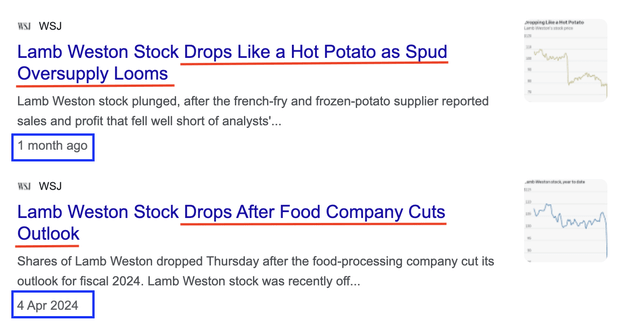
The Wall Street Journal
Although this hurt our investment, we bought more, as we are very confident in the future of this struggling french fry producer.
So, let's keep the intro short and discuss why I believe Lamb Weston (NYSE:LW) offers tremendous value for long-term investors.
French Fries Are A Great Place To Be
Personally, I own one stock in the consumer staples sector. That company is PepsiCo (PEP), a company I admire for its successful product portfolio, which provides it with pricing power, anti-cyclical growth, and the ability to consistently grow its dividend.
Lamb Weston is similar yet different.
Like PepsiCo, it produces anti-cyclical products: french fries and related fried potato products. Although there is a cyclical aspect to french fries, the company enjoys a rather anti-cyclical demand profile (people need to eat).
The company's products, which are produced in 27 factories around the world, are sold in more than 100 nations.
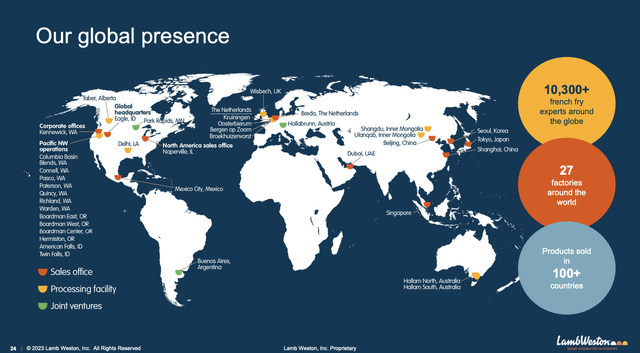
Lamb Weston Holdings
The best thing about fries is their popularity.
Using data from GlobalData, Lamb Weston reported that 42% of global menus in 2023 came with fries. french fries are the favorite food of all generations, followed by burgers, which are often consumed with a side of fries as well.
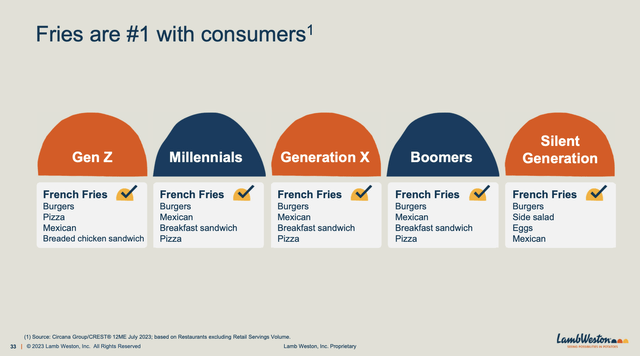
Lamb Weston Holdings
Not only are french fries tasty, but they are also great for restaurant margins! As we can see below, third-party research shows that no side dish is more profitable for restaurants than french fries.

Lamb Weston Holdings
As a result, demand growth is strong, even in developed markets. As we can see below, in the 2022-2027E period, QSR unit growth is expected to be 3% in the United States. Markets in Latin America are expected to see 6-21% growth, with major Asian markets growing between 3-7%. Surprisingly (to me), most of these nations have a higher fry-order frequency than the United States.

Lamb Weston Holdings
Moreover, in addition to having a wide variety of products for consumers and businesses, the company benefits from McDonald's (MCD) success, as it generated 13% of its 2023 sales from this fast-food giant.
When I published my article in April, I got a lot of messages from restaurant owners who had great things to say about LW products. One person even won the award for selling the best french fry in his town.
So far, I have basically recycled a lot of the info I used in my prior article. Now, it's time to discuss the company's stock price sell-off, as there's a lot to unpack.
FY2024 Was A Hot Mess
Last month, Lamb Weston reported the fourth quarter earnings of its 2024 fiscal year. This included a discussion of strategic measures to control costs and modernize its business.
For example, the company introduced new technologies to expand its total addressable market, upgraded its ERP (Enterprise Resource Planning) System, and focused on supply chain productivity.
Unfortunately, the implementation of its ERP system caused a huge problem. Essentially, it was the reason the stock sold off after its third-quarter earnings.
As an ERP system is used to run an entire business, supporting automation and processes in finance, human resources management, supply chains, services, procurement, and others, the company's transition turned into a nightmare.
In 3Q24, total sales declined by 16%, mainly driven by unfilled orders from its ERP transition. Customers were simply unable to get their goods, leaving a lot of unsold products in the company's warehouses.
The transition to a new enterprise resource planning ("ERP") system in North America negatively impacted our financial results in the quarter by more than we expected,” said Tom Werner, President and CEO. “The ERP transition temporarily reduced the visibility of finished goods inventories located at distribution centers, which affected our ability to fill customer orders. - Lamb Weston
On top of that, Lamb Weston is hurting because consumers are cutting back on restaurant spending. Although inflation has been on a steady decline since last year, it has been elevated since 2021, increasingly pressuring the middle class.
In 4Q24, this caused LW sales to fall short of their targets due to three major reasons:
- Higher-than-expected market share losses and soft demand. The company encountered ERP-related market share losses and soft demand for fries, especially in key markets like the United States and Europe, where restaurant traffic trends are weak.
- An unfavorable product mix and voluntary product withdrawals. Due to a less favorable sales mix, the company decided to withdraw some products to focus on quality.
- Execution challenges. The company made the case its level of execution was "unacceptable." It knows it has the potential to benefit from a strong global market but failed to do so.
As we can see below, total net sales were down 5%. Operating income was down 14% Adjusted EBITDA was down 15%. Adjusted EPS was down 40%.
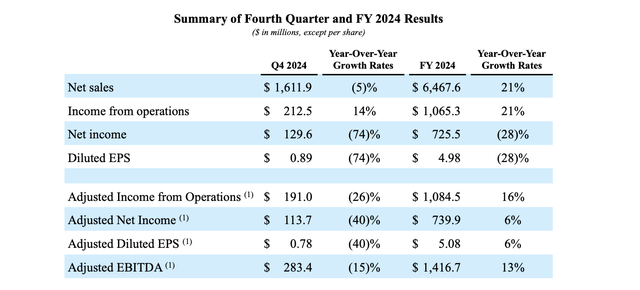
Lamb Weston Holdings
It also does not help that cost pressure is an issue. The company expects that any net impact from inflation-driven pricing actions will have a minimal contribution to net sales in its 2025 fiscal year. To make matters worse, a below-average potato crop yield in Europe is expected to create an additional headwind.
In general, when discussing 2025, the company is very cautious, as it expects a potential volume decline in the first half of the year. This is mainly based on consumer uncertainty and related traffic softness. According to the company, U.S. restaurant traffic in 4Q24 was down 3%. Traffic at hamburger places was down more than 4%.
As a result, it expects full-year 2025 sales of $6.6 billion to $6.8 billion, with net income of at least $630 million. This would indicate at least 1.5% sales growth.
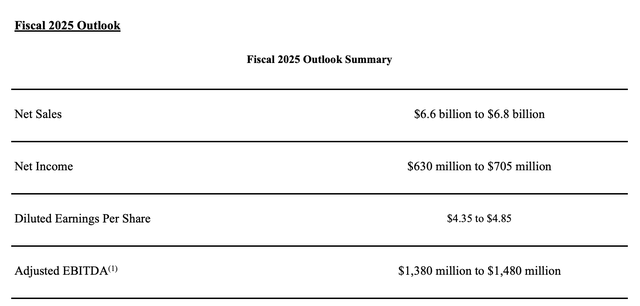
Lamb Weston Holdings
The good news is that there's plenty of shareholder value.
Great News For Shareholders
In order to capitalize on future growth and improve its supply chain, the company has allocated roughly $990 million to CapEx in 2024, a major increase of $255 million compared to 2023. These investments are focused on modernizing production facilities, including in the Netherlands and Argentina.
On top of that, despite challenges, the company maintains a healthy balance sheet with a net debt leverage ratio of 2.7x adjusted EBITDA.
Meanwhile, the net debt declined by roughly $40 million from the third quarter to $3.75 billion, and the company continues to enjoy substantial liquidity, including $1.2 billion available under a new global revolving credit facility.
It is also expected to generate substantial free cash flow, as analysts expect free cash flow to accelerate to $225 million in FY2025, potentially followed by a surge to roughly $480 million in FY2027.
As the company has a market cap of slightly less than $9 billion, we're dealing with an implied free cash flow yield of 2.5% for FY2025 and 5.3% for FY2027. This is great for its dividend.
Since its spin-off from Conagra Brands (CAG), the company has aggressively hiked its dividend. On December 14, 2023, the company hiked its dividend by 29% to $0.36 per share per quarter. This translates to a yield of 2.3%.
 Data by YCharts
Data by YCharts
The five-year dividend CAGR is 11.4% with a current earnings payout ratio of 25%.
On top of using buybacks to distribute excess free cash flow, the company aims for a dividend payout ratio of 25% to 35%. Given the current payout ratio, future EPS growth is likely to translate to elevated dividend growth.
Even before LW sold off, it had a great dividend profile, as a subdued yield came with elevated dividend growth expectations. Although growth has come down, we're now dealing with a stock yielding more than 2% and aggressive dividend growth potential.

Lamb Weston Holdings
Speaking of growth, using the FactSet data in the chart below, the company is expected to see an 11% EPS contraction in the fiscal year ending May 2025. In the two years after that, growth is expected to accelerate by 14% and 8% in FY2026 and FY2027, respectively.

FAST Graphs
Applying an 18x multiple gives us a fair stock price of $99, 60% above the current price.
Also, note that this data sees $5.12 in EPS for the 2026 fiscal year. In April, that number was $7.31. In other words, if the company is able to improve efficiencies and gain market share, I expect a much higher stock price than $99 in the next few years.
Hence, while I cannot and will not deny that LW is in a very tough spot, I really like the long-term value this stock brings to the table. As a result, we will keep buying for family portfolios, as we believe the value at current prices is hard to beat.
Takeaway
Despite Lamb Weston's rough year marked by two significant stock price declines and significant challenges, I remain confident in its long-term potential.
The company's dominant position in the global french fry market, combined with its commitment to modernizing its operations and a solid dividend growth strategy, provides a strong foundation for future gains.
While the short-term outlook may be rocky, especially with pressure on consumer spending, the current valuation offers an attractive upside.
I believe investors who can stomach volatility with a long-term mindset can benefit from the company's long-term growth potential and favorable dividend growth profile.
Pros & Cons
Pros:
Strong Market Position: Lamb Weston is a global leader in french fries, an anti-cyclical product with solid demand even in tough economic climates. Fries are popular and highly profitable for restaurants, which keeps demand steady.
Growth Potential: With ongoing investments in modernizing facilities and improving efficiencies, there's significant potential for operational growth and margin improvements in the long term.
Attractive Dividend: A healthy balance sheet supports an attractive dividend profile. Last year's 29% dividend hike and future free cash flow growth point to continued elevated shareholder returns.
Cons:
- Short-Term Headwinds: Recent issues related to ERP transition and softening restaurant traffic have impacted sales and could continue to pose challenges in the near term.
- Dependency on the Restaurant Industry: LW's business is closely tied to the performance of the restaurant industry, exposing it to fluctuations in consumer spending and dining trends.
- Potential for Supply Chain Disruptions: The company's operations may be vulnerable to other supply chain disruptions in the future.
Disclaimer: Investing carries risk. This is not financial advice. The above content should not be regarded as an offer, recommendation, or solicitation on acquiring or disposing of any financial products, any associated discussions, comments, or posts by author or other users should not be considered as such either. It is solely for general information purpose only, which does not consider your own investment objectives, financial situations or needs. TTM assumes no responsibility or warranty for the accuracy and completeness of the information, investors should do their own research and may seek professional advice before investing.

